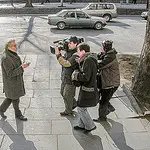 About half of our bookings come from communications managers or directors who hire us to work with their executive teams.
About half of our bookings come from communications managers or directors who hire us to work with their executive teams.
During our initial phone calls, they often confide two things to me:
1. Their bosses are control freaks.
2. During media interviews, their bosses tend to drone on and on.
As a media trainer, those two pieces of information are music to my ears. It’s easy for me to work with controlling executives who say too much during media interviews.
When I work with them, I often begin with a practice interview—usually a non-live “sound bites” interview, during which reporters just look for a few quotes to run. I let the executives drone on for as long as they like.
When we finish the mock interview, I ask the trainee a straightforward question: “I’m surprised that you weren’t focused on controlling the news story. How come?”
The trainees are usually confused by my assertion, protesting that of course they were interested in remaining in control.
I then explain to the executives that by saying so much, they voluntarily handed control to the reporter, who gets to decide for them which of their dozens of quotes to use. The longer their answers go, the more control they’re ceding. I liken it to handing their car keys over to another driver. If they’re not driving, the reporter is.
Once the executive understands that control and brevity are linked, I don’t need to say much more. Their answers become tighter (and better). They increase the chances of reporters quoting their most important points instead of a tertiary “oh, by the way” one.
They buy into my instruction without a fight because I’m speaking their language of control.
That’s not to say that they should give a three-second answer and abruptly stop. The balance for spokespersons is to speak long enough to get their messages across, but not so long that their messages get drowned out by unnecessary verbiage.
You can read more about the perfect length of a media answer here.


